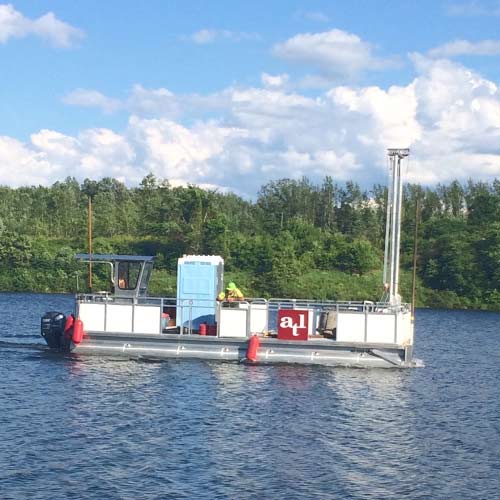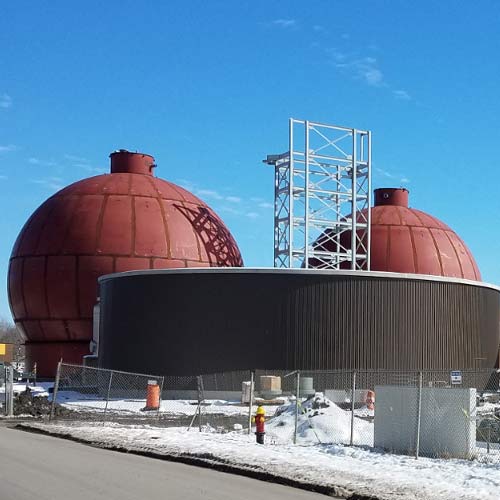Click the following link to view the PDF of this paper: PFAS in New York State

Cheyenne J. Dashnaw, PE
Senior Engineer
Atlantic Testing Laboratories
Per- and Polyfluoroalkyl Substances (PFAS) are a group of man-made chemicals, including perfluorooctanesulfonic acid (PFOS) and perfluorooctanoic acid (PFOA), used in the production of a wide variety of consumer goods. PFAS have been commonly found in food packaging, household cleaning products, stain repellents, pesticides, and fire-retarding foam. PFAS can collect in water and soil, where the contaminants enter the food chain or are directly consumed by humans.
Despite no longer being produced in the United States, PFAS are persistent in the environment and readily accumulate in the human body, with half-lives in the human body ranging from 4 to 10 years. The most common impact on human health is high cholesterol, but some PFAS can cause low infant birth weights, affect the immune system, disrupt thyroid hormone balances (PFOS), and is possibly a human carcinogen1 (PFOA).
PFAS chemicals have been phased out by industry, but can still be found in air, soil, and water, including sources of drinking water. Common sources of exposure come from food production in soil contaminated by PFAS, biodegradation of consumer products, production facilities that formerly used PFAS, and contaminated drinking water sources. The contaminated drinking water is normally localized to communities near industrial facilities that used PFAS, oil refineries, airfields, and other areas where PFAS may have been used in firefighting or related training operations.
The EPA has methods 537 and 537.1 for analysis of potable water by solid phase extraction (SPE) and liquid chromatography with tandem mass spectrometry (LC-MS/MS). EPA also has draft method 1633 for the analysis of PFAS in aqueous, solid, biosolids, and tissue samples by LC-MS/MS. The LC-MS/MS analytical technique consists of initially separating target compounds (LC process), and then completing mass-based detection with triple quadrupole mass spectrometers. The first quadrupole ionizes molecules, the second quadrupole fragments molecular ions, and the third quadrupole isolates the ions for measurement with a detector. The LC-MS/MS method allows for highly sensitive detection.
In New York State, the New York State Department of Health (NYSDOH) Environmental Laboratory Approval Program (ELAP) offers certification for PFAS analysis in drinking water (using EPA Methods 537 and 537.1 or the latest edition of ISO Method 25101). ELAP certification is not yet available for non-potable water or solids.
In January 2021, via regulatory oversight given by the United States Environmental Protection Agency (USEPA), the New York State Department of Environmental Conservation (NYSDEC) Division of Environmental Remediation (DER) released a technical guidance document titled, “Sampling, Analysis, and Assessment of Per- and Polyfluoroalkyl Substances (PFAS),” requiring sampling and analysis of environmental media for PFAS as part of remedial programs under 6 NYCRR Part 375. This guidance document has since been updated, with the current version dated June 2021 and a draft update version dated June 2022.
Guidance values for limits in soil have been developed for sites in New York State, but soil cleanup objectives (SCO) are not planned to be established until at least a proposal and approval in a future revision to 6 NYCRR Part 375-6. The current guidance gives limit values for PFOA and PFOS, based on the anticipated site use for soil and groundwater. While regulations are in progress, it is important to rely on knowledgeable environmental scientists and engineers to ensure that sampling and analysis are completed reliably and in accordance with the most recent and updated regulatory standards.
If you have a project that may require soil, water, or air sampling for PFAS or any other analyte, ATL, a WBE certified company, has experienced environmental professionals located throughout New York State to perform sampling and coordinate applicable analysis.
For more information, contact Cheyenne Dashnaw, PE at 315-386-4578, info@atlantictesting.com, or visit www.AtlanticTesting.com.
[1] International Agency for Research on Cancer (IARC)
|
ASSOCIATED SERVICES |
 |









































